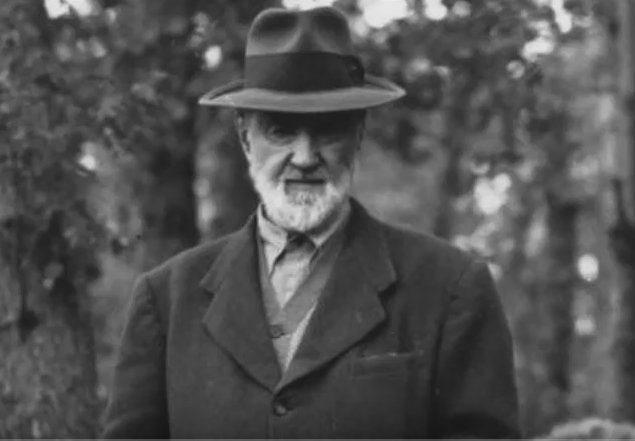Ragtime? Yes. Slightly syncopated melodies over a hint of marching “oom-pah” bass are everywhere in Charles Ives. A personal favorite is “In the Inn,” heard in the Piano Sonata No. 1, also arranged for ensemble as part of A Set of Pieces. The recording by Orpheus Chamber Orchestra (featuring Gilbert Kalish as guest pianist) is just great.
However, there is not really jazz in Ives, partly because he was born a little too early. If the dates of his peak creativity had occurred a decade or two later, maybe Ives would have appropriated Jelly Roll Morton and Louis Armstrong in the manner that he appropriated Scott Joplin — although that would have also meant working with source material that wasn’t written down (more on that below).
In a related topic: While the straightforward minstrel humor of Debussy’s “Golliwog’s Cakewalk” and many other ragtime borrowings from the turn of the century are now considered dated or even racist, Ives’s ragtime quotations are usually uncompromisingly modernist.
However, no white person was ever nominated as the king of the blues. W.C. Handy was the Father of the Blues (thanks to writing some of it out) and Bessie Smith was the Empress of the Blues. Those designations are more acceptable.
There is not really blues in Charles Ives, either — or is there?
I don’t know what Bessie Smith or Robert Johnson would say about that preceding academic paragraph. My guess is that they wouldn’t approve. Instead they would say something like, “The blues is a feeling.” And they would be right.
Still, just bear with me as I try to tease out something bluesy concerning mash-ups and undoing a system.
(Picking a pop culture example almost at random: the hero of Len Deighton’s spy novel Funeral In Berlin — a huge bestseller in the 60s, Michael Caine starred in the movie — wants to go to a symphonic concert “…on account of the Charles Ives Three Places in New England, because I liked the crazy military band sequence.”)
One inevitable result of this collision is a blurring of texture. It’s murky.
In his autobiography The Night People: Reminiscences of a Jazzman, Dicky Wells (best known as a key trombonist for Count Basie in the early years) says that “murky” was a term used for black music before “funky” took over. If you could play murky, you could get more gigs.
Gorman made the scale the blues. Gorman made the scale “murky.”
Of course, that Gershwin/Gorman gesture went on to be one of the defining moments in all of American symphonic music.
To this day, the Gershwin score is printed as a straight scale. You gotta know the oral tradition in order to play it right.

Still, at first glance Scott Joplin seems notated, his pages look like normal piano music, and therefore Joplin will always be easier to appropriate than Louis Armstrong or Jelly Roll Morton, let alone Bessie Smith or Robert Johnson.
(Indeed, the published scores of W.C. Handy are widely considered to be a skeletal starting point in a way that Joplin’s scores are not. After all, how are you gonna write out the blues?)
I especially enjoy the calmer moments where Ives’s band holds down something familiar underneath epic discordant decoration. The result is surely murky, and sometimes it even seems truly “bluesy.” Off the top of my head, I can think of three lovely instances: the G major section of “Thanksgiving” from Holiday Symphony, the E dominant vamp in “The ‘St. Gaudens’ in Boston Common (Col. Shaw and his Colored Regiment)” from Three Places in New England, and the most sustained and famous example, The Unanswered Question.
In The Unanswered Question, the string chorale stays in G while the trumpet and winds do contrasting esoteric things. It is not a stretch to say that the horns are defacing the harmony in the manner I ascribe to the blues above. Indeed, the first trumpet note is a B-flat, in other words the “bluesiest” note over a G major chord!

When I mentioned this lovely detail to Mark Stryker, Mark suggested that it would be possible for the trumpet to play the opening Unanswered Question solo in the manner of Louis Armstrong (open, joyous) or Miles Davis (muted, vulnerable). Mark is right!
The final confirmation of the blues in Ives comes from an unimpeachable source: Bill Frisell, who takes the E dominant vamp from “The ‘St. Gaudens’ in Boston Common (Col. Shaw and his Colored Regiment)” and adds Joey Baron on blues drums and Don Byron on improvised blues clarinet for his album Have A Little Faith.







More Stories
CD review: George Benson – Dreams Do Come True: When George Benson Meets Robert Farnon – 2024: Video, CD cover
The band was tight as ever. The Warren Haynes Band cuts loose: Video, Photos
Interview with Alvin Queen: Feeling Good – I heard these tunes played by … Video, new CD cover, Photos